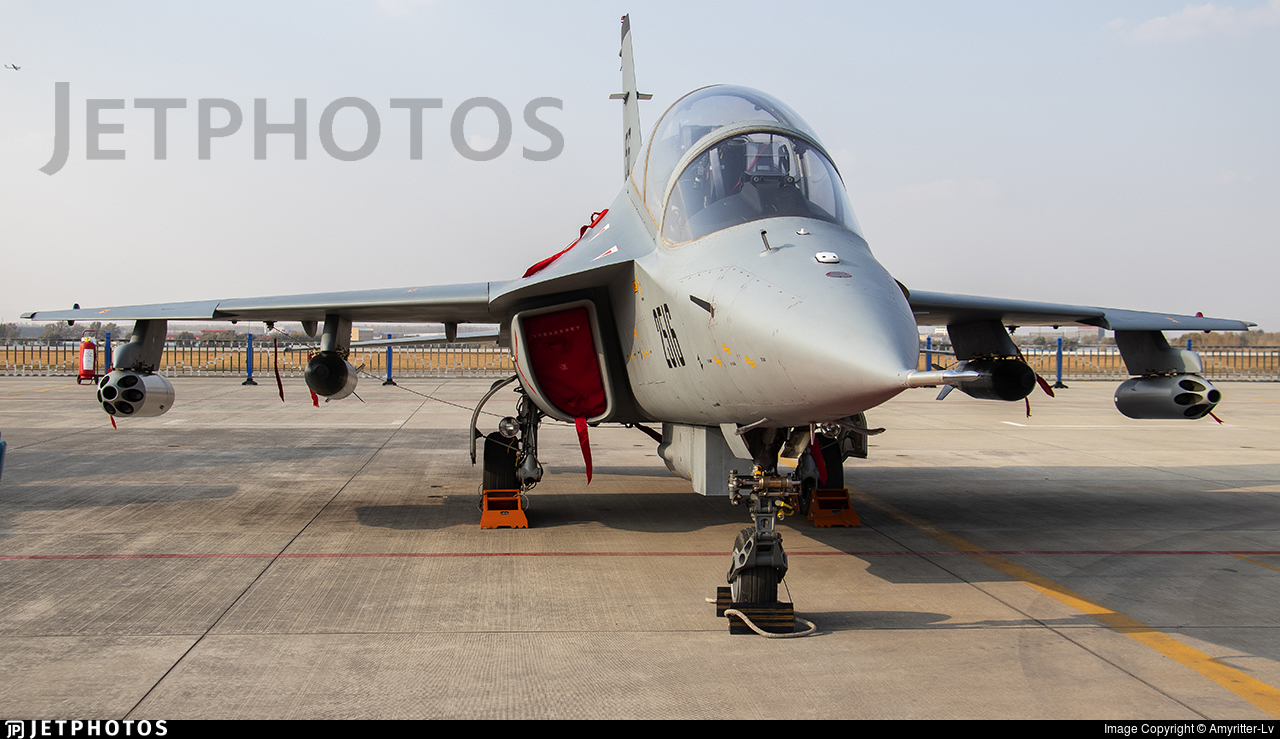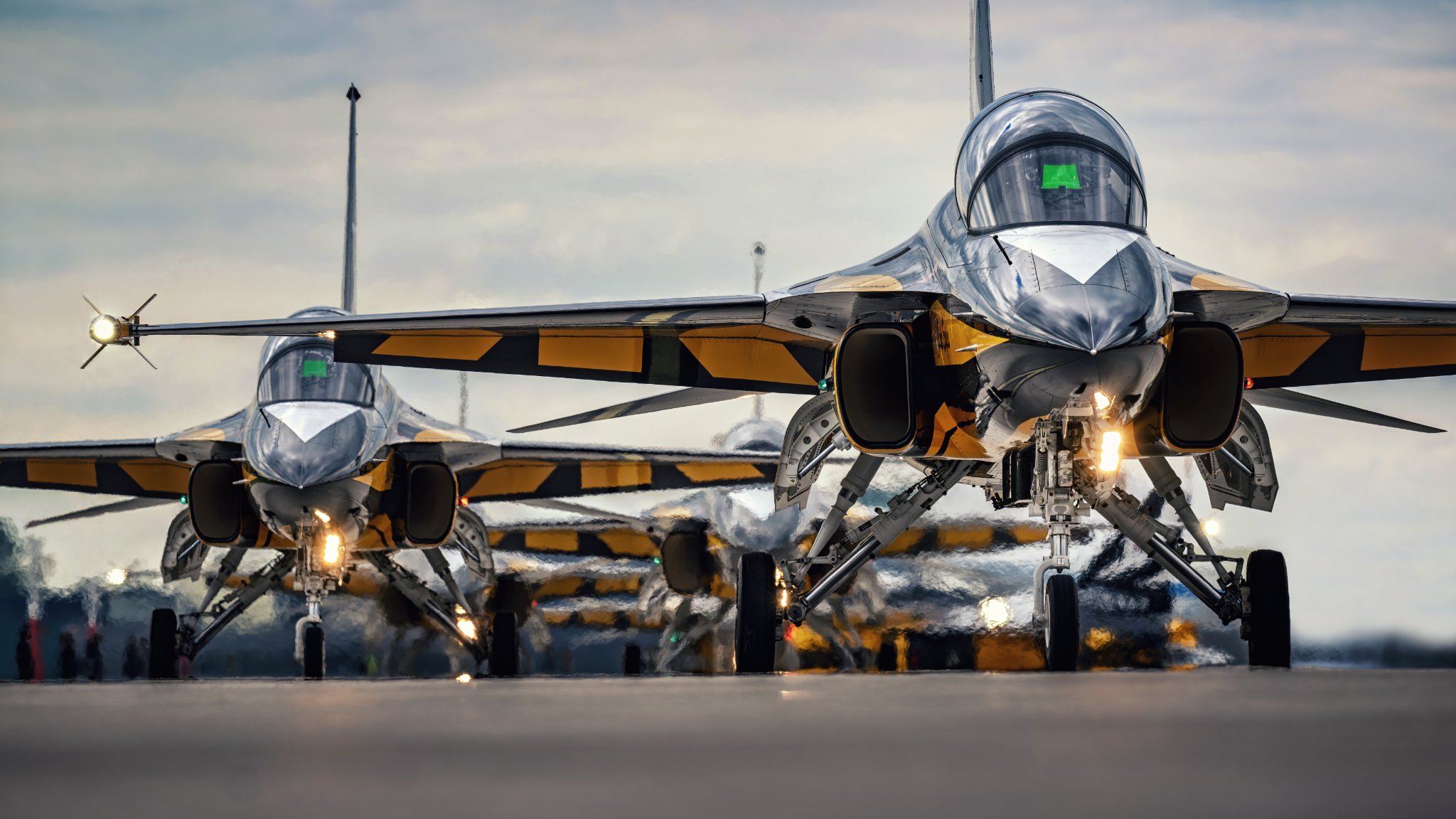Latest Thread
- Iran The new Shahed-161 jet drone
- Bangladesh Air-Force Bangladesh Air Force setting up drone manufacturing plant in JV with China
- Bangladesh Bangladesh eyes arms exports
- Azerbaijan Military parade in Baku on November 8
- Russia Russia Offers Sukhoi SJ-100 to India with Local Manufacturing Passenger Jets in India
You are using an out of date browser. It may not display this or other websites correctly.
You should upgrade or use an alternative browser.
You should upgrade or use an alternative browser.
It'd look much nicer if the canopy extended and was flush with the fuselage in the area highlighted. I don't know if we can't make it that way (due to technological hurdles) or if it was a design choice but it does take away from it both aesthetically and in terms of craftsmanship appearance comparing with peer competitors (T-7, JL-10, T-50 for comparison; theirs also protruding outwards much more than Hürjet, kind of mimicing a bubble canopy).


Last edited:
During this plane’s airframe design work, the Brazilian company Akaer has been heavily and extensively involved. They are the force and design team behind the successful work achieved in designing the Gripen E and F blocks.View attachment 60943
It'd look much nicer if the canopy extended and was flush with the fuselage in the area highlighted. I don't know if we can't make it that way (due to technological hurdles) or if it was a design choice but it does take away from it both aesthetically and in terms of craftsmanship appearance comparing with peer competitors (T-7, JL-10, T-50 for comparison; theirs also protruding outwards much more than Hürjet, kind of mimicing a bubble canopy).



Akaer's role in the Hurjet project was to take care of the structural part of the aircraft, providing calculations to produce the most suitable fuselage, especially the rear and central part of the plane's body. TAI went after one of the best specialists in this market and gave Akaer the job.
Performance and efficiency of design were of paramount importance rather than how “nice” it looked.
This is a plane where 5th generation KAAN’s pilots are going to be trained on. It is also supposed to be in possession of an airframe good enough to perform as an acrobatic show plane. Thirdly it will be a CAS or Light Attack Aircraft. To achieve these goals is more important than aesthetics.
I am glad to hear that the test of Hurjet is proceeding as planned, but it's important to not stop producing more hurjets and just keep building them. We need more prototypes, who at the end can be turned into light fighter jets.
All the jets being produced will have to pass tests before they can be flown, so it's important to keep building them, if we're going to have 80-90 hurjets, then we can't stop producing them. if it can fly and carry missiles, then it's good enough.
We'll never know when the wesdt decides to say no to selling us jet engines, so build 1 hurjet a month and make them airworthy.
@MADDOG can you say anything or know if we have more hurjets in production ?
All the jets being produced will have to pass tests before they can be flown, so it's important to keep building them, if we're going to have 80-90 hurjets, then we can't stop producing them. if it can fly and carry missiles, then it's good enough.
We'll never know when the wesdt decides to say no to selling us jet engines, so build 1 hurjet a month and make them airworthy.
@MADDOG can you say anything or know if we have more hurjets in production ?
I've read many many times not only on this forum but also on twitter and other defense forums that twin tf10k might power Hürjet. I dont see, how this is remotely possible. Diameter of F404 89 cm, Considering TF10k will have over 1:1 bypass ratio, It can be expected to have diameter around/above 70cm but Ive read number as high as 87cm. That puts its diameter almost around f404. Tei's prototype on Teknofest confirms such number since those part are expected to be used in a working engine. I'm pretty sure nobody expects Hürjet to be bigger than EF Typhoon or Rafael. So, Hürjet with twin TF10k is simply impossible and We should stop dreaming about it.
I've read many many times not only on this forum but also on twitter and other defense forums that twin tf10k might power Hürjet. I dont see, how this is remotely possible. Diameter of F404 89 cm, Considering TF10k will have over 1:1 bypass ratio, It can be expected to have diameter around/above 70cm but Ive read number as high as 87cm. That puts its diameter almost around f404. Tei's prototype on Teknofest confirms such number since those part are expected to be used in a working engine. I'm pretty sure nobody expects Hürjet to be bigger than EF Typhoon or Rafael. So, Hürjet with twin TF10k is simply impossible and We should stop dreaming about it.
- F404 has 11.000 dry and 17.700 afterburner thrust
- TF10K has 6.000 dry and 10.000 wet thrust x 2 = 12.000 dry and 20.000 wet thrust
- dry power is 9% more than the F404
- and wet power is 13% more
Hurjet's Main fusuleage designed to hold one F404. F404 and TF10k will be very similar in size like I mentioned in previous post. They need to design whole main fuselage thus whole aircraft needs a redesign in order to fit 2x tf10k. I repeat, Aircraft with twin tf10k will be almost as big as EF Typhoon or Rafael that is why. And That would not be a Hürjet.Looks like the power levels are not far off. I don't see why not.
- F404 has 11.000 dry and 17.700 afterburner thrust
- TF10K has 6.000 dry and 10.000 wet thrust x 2 = 12.000 dry and 20.000 wet thrust
- dry power is 9% more than the F404
- and wet power is 13% more
Any airframe without reduced radar cross signal is almost useless on heavy contested wartime if oppenent has got one,this even for awacs planes,becuse air to air missiles getting longer ranges,and awacs planes can not detect stealth fighters from a safer zone.
That's OK, we can have Hürjet Make-2. It wasn't too hard making Hürjet Make-1 anyway.Hurjet's Main fusuleage designed to hold one F404. F404 and TF10k will be very similar in size like I mentioned in previous post. They need to design whole main fuselage thus whole aircraft needs a redesign in order to fit 2x tf10k. I repeat, Aircraft with twin tf10k will be almost as big as EF Typhoon or Rafael that is why. And That would not be a Hürjet.
Why the hell would turkey want to go redesign an entire aircraft for a twin engjne design if they have KAAN for that? If anything they have access to radar chamber facilities to remake a single stage engine for a stealth hurjet design which in my opinion would be the greatest choice and maybe making a UAV version of it as well at that point who needs f-35s or f-16s.That's OK, we can have Hürjet Make-2. It wasn't too hard making Hürjet Make-1 anyway.
TF6K engine is close to being a reality but the TF35K engine is still far away, so as the saying goes "one bird in the hand is worth two in the bush". We need to make full use of this engine to be on the safe side.Why the hell would turkey want to go redesign an entire aircraft for a twin engjne design if they have KAAN for that? If anything they have access to radar chamber facilities to remake a single stage engine for a stealth hurjet design which in my opinion would be the greatest choice and maybe making a UAV version of it as well at that point who needs f-35s or f-16s.
Temel Kotil has emphatically and repeatedly rejected the possibility of a twin-engined Hürjet. Besides, it'd be basically another aircraft anyway and it isn't like we get the TF6K tomorrow or sth. First prototype will be finished this year, and we'll need it to be immaculate to continue with the schedule to have it ready for mass production in 3, 4 years at best.
Did he say it is impossible, no he didn't. All he did is refute there are plans to make such a plane. Two different things.Temel Kotil has emphatically and repeatedly rejected the possibility of a twin-engined Hürjet. Besides, it'd be basically another aircraft anyway and it isn't like we get the TF6K tomorrow or sth. First prototype will be finished this year, and we'll need it to be immaculate to continue with the schedule to have it ready for mass production in 3, 4 years at best.
Which is what matters. Many things are possible, but they are not probable. I can walk to Van, but I probably won't. It's the same thing.Did he say it is impossible, no he didn't. All he did is refute there are plans to make such a plane. Two different things.
Yes and no at the same time. Although TAI can be rather innovative and flexible when it comes to assembly activities there is no denying that the site itself is reaching its natural limit. No 10 is reserved for civil/military production of the aero structures group. Hürjet's production facilities used to house aircraft undergoing mods and during assembly still housed F-16's that were undergoing their own modernization programs. The only brand new facility set up for production and assembly is MMU's hangar. TAI certainly needs further expanding. Maybe not now but perhaps in the near future.@MADDOG ,can you confirm that?
The thing is when the shit hits the fan you make ships walk on land to win a victory. If there is a technical possibility, a high level decision is all you need to make it happen.Which is what matters. Many things are possible, but they are not probable. I can walk to Van, but I probably won't. It's the same thing.
Last edited:
Didnt see anyone post this.
hurjet has activates its afterburner for the first time.
So question is, is it the one flying or a second one on the ground ?
hurjet has activates its afterburner for the first time.
So question is, is it the one flying or a second one on the ground ?
Didnt see anyone post this.
We turned on the Hürjet's afterburner.
HÜRJET continues its dual-cockpit, high-tach performance tests.
After burner and pass tests were successfully carried out.

 www.instagram.com
www.instagram.com
For better quality video:
After burner and pass tests were successfully carried out.

TUSAŞ Türk Havacılık ve Uzay Sanayii on Instagram: "HÜRJET çift kokpitli, yüksek takat performans testlerine devam ediyor. After burner ve pas geçme testleri başarı ile gerçekleştirildi. 🇹🇷💪🏻 @savunmasanayii"
8,230 likes, 81 comments - turkishaerospace on October 4, 2023: "HÜRJET çift kokpitli, yüksek takat performans testlerine devam ediyor. After burner ve pas geçme testleri başarı ile gerçekleştirildi. 🇹🇷💪🏻 @savunmasanayii".
 www.instagram.com
www.instagram.com
For better quality video:
Last edited:









